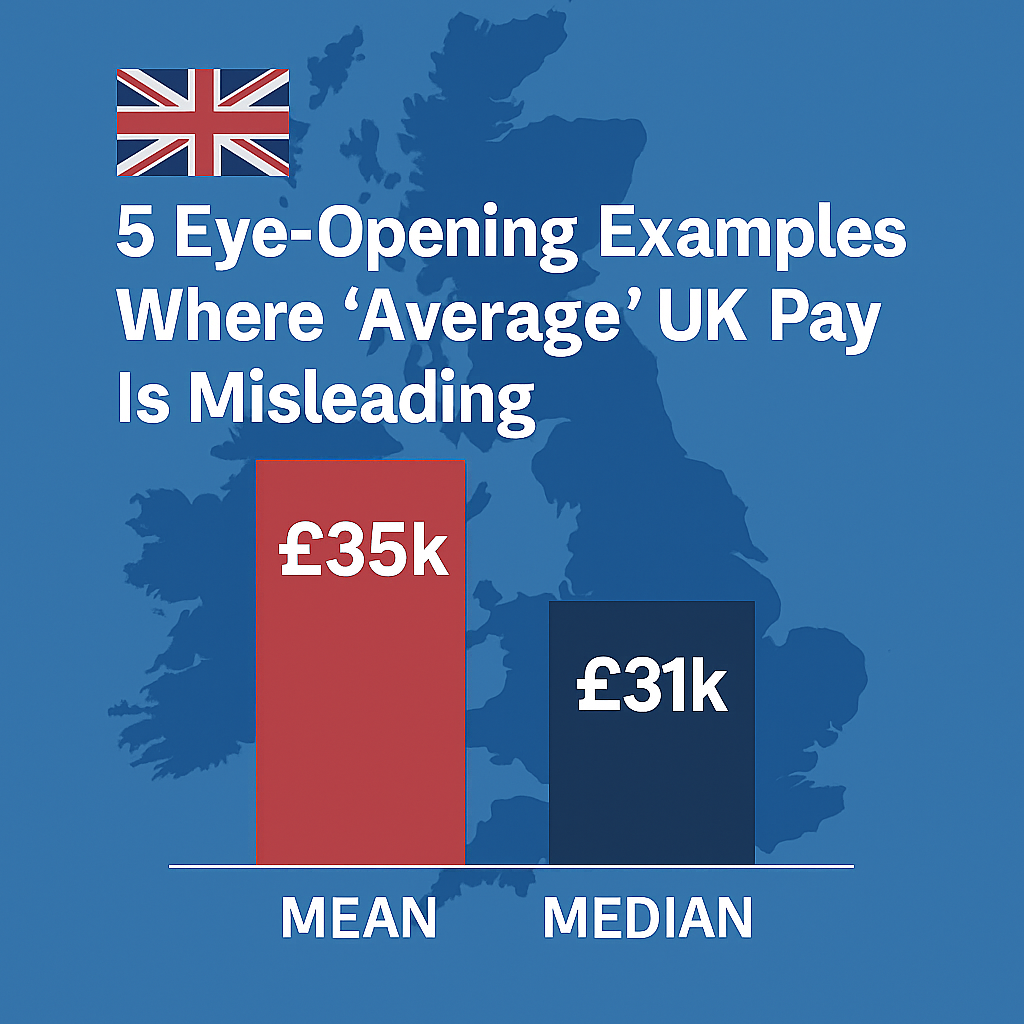Discover 5 eye-opening examples showing how the average UK pay and salary figures can mislead. From house prices to football wages, learn why median averages reveal the real story behind the numbers—and what it means for you.
5 Eye-Opening Examples Where Average UK Pay Is Misleading – Table of Contents
The Problem With Averages: What Median vs Mean Really Tells Us About Money in the UK
When a headline shouts that the “average salary in the UK is £35,000,” it can paint a picture of national prosperity. But scratch beneath the surface, and you’ll find the numbers aren’t telling the full story.
The truth is, there are two very different ways to calculate an average: mean and median. While they sound similar, they can produce dramatically different results—especially in a country like the UK, where wealth and income are heavily skewed toward the top.
This article explores how averages can be misleading by looking at five everyday examples: salaries, house prices, public vs private sector pay, footballer wages, and transport industry pay. In each case, we’ll show how the median (the middle value) often tells a truer story than the mean (the mathematical average).
What’s the Difference Between Mean and Median?
- Mean is the total of all values divided by the number of values.
- Median is the middle value in a sorted list of numbers.
Example: If seven people earn £18k, £20k, £22k, £24k, £26k, £28k, and one person earns £150k:
- The mean is £41.7k.
- The median is £24k.
Despite six out of seven people earning below £30k, the mean average is pushed up dramatically by a single high earner. This shows how the mean can give a distorted view of what most people are actually earning.
1. UK Salary Reports
The Headline Number
“The average salary in the UK is £35,000.”
Often quoted by media and politicians, this figure typically refers to the mean salary.
The Real Picture
- Mean salary (all employees): £35,404 (ONS, 2024)
- Median salary (all employees): £31,602
The difference? Nearly £4,000.
Why? The top 10% of earners (e.g. high-paid executives, City professionals) bring in over £70,000, dragging the mean up. Meanwhile, those at the bottom 10% earn less than £22,000.
Why It Matters
People might assume that earning £35,000 makes them average, when they’re actually above the midpoint. For job seekers, policymakers, or anyone benchmarking average UK pay, this creates confusion.
Bottom Line
The average salary we hear in headlines is higher than what most people actually take home.
2. House Prices in London

The Headline Number
“The average house price in London is over £500,000.”
This mean figure is often used in national coverage.
The Real Picture
- Mean house price (London): £524,000 (ONS, 2024)
- Median house price (London): £440,000
That’s an £84,000 difference—a meaningful amount in the world of mortgages and affordability.
Why It Matters
The mean is inflated by luxury properties in areas like Kensington, Hampstead, or Mayfair. The median better reflects what most first-time buyers or average earners can expect.
Bottom Line
Luxury flats distort the picture—most Londoners are buying far below the ‘average’ reported price.
3. Public vs Private Sector Pay
The Headline Number
“Public sector workers earn more than private sector workers.”
This claim often uses mean figures and sparks political debate.
The Real Picture
- Mean pay (public sector): Higher, partly due to senior roles like judges, NHS consultants, and civil servants.
- Median pay: Closer between sectors. For many job types, private sector pay is equal or higher.
In 2023, the median public sector wage was slightly higher overall, but not once you account for qualifications, age, and job types (ONS, 2023).
Why It Matters
Using the mean inflates perceived public sector pay, which can be used unfairly in political arguments about spending, strikes, or recruitment.
Bottom Line
Public sector pay averages are skewed by a small number of top earners.
4. Footballers’ Wages
The Headline Number
“Premier League players earn £60,000 a week.”
That’s the mean wage across all Premier League players.
The Real Picture
- Mean wage: ~£60k/week = £3.1m/year
- Median wage: Estimated around £30k/week or lower (PFA & Sporting Intelligence estimates)
Why? A handful of top players (like Erling Haaland or Mo Salah) earn £200k+ per week, dramatically skewing the average.
Why It Matters
Aspiring footballers, parents, and fans may vastly overestimate how lucrative a career in football actually is.
Bottom Line
A few superstar salaries make it seem like all footballers are millionaires—most aren’t.
5. Transport Industry Wages
The Headline Number
“The average salary in rail is over £50,000.”
Often used in coverage of train strikes or union negotiations.
The Real Picture
- Mean wage (rail industry): ~£53,000 (Department for Transport, 2023)
- Median wage (train drivers): ~£50,000
- Median for other roles (e.g. conductors, station staff): often £28,000–£40,000
The mean includes well-paid train drivers and senior managers, while the wider workforce earns considerably less.
Why It Matters
During strike coverage, this figure has been used to paint rail workers as overpaid, fuelling division without reflecting the full range of roles in the industry.
Bottom Line
Not all rail workers are on train driver salaries—but the average figure suggests they are.
Final Thought
When it comes to average UK pay, house prices, or wages, mean averages often flatter to deceive. In an unequal country, the median offers a more honest, grounded picture of how people are actually living.
So next time you see an “average” headline, ask yourself: Is it mean, or is it meaningful?

